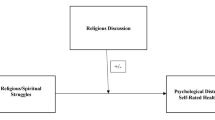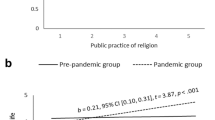Abstract
The purpose of this study was to determine whether distinct latent profiles of religiousness/spirituality exist for ALWH, and if so, are latent profile memberships associated with health-related quality of life (HRQoL). Latent profile analysis of religiosity identified four profiles/groups. Compared to the other three groups, higher levels of emotional well-being were found among young perinatally infected adolescents who attended religious services, but who did not pray privately, feel God’s presence or identify as religious or spiritual. Social HRQoL was significantly higher among the highest overall religious/spiritual group. Understanding adolescent profiles of religiousness/spirituality on HRQoL could inform faith-based interventions.
Trial registration NCT01289444.

Similar content being viewed by others
References
Asparouhov, T., & Muthén, B. (2012). Auxiliary variables in mixture modeling: A 3-step approach using Mplus. Mplus web notes: No. 15.
Astin, A. W., Astin, H. S., Lindholm, J. A., & Bryant, A. N. (2005). The spiritual life of college students: A national study of students’ search for meaning and purpose. Los Angeles, CA: Higher Education Research Institute, UCLA.
Barton, Y. A., & Miller, L. (2015). Spirituality and positive psychology go hand in hand: An investigation of multiple empirically derived profiles and related protective benefits. Journal of Religion and Health, 54, 829–843.
Bernstein, K., Lyon, M. E., & D’Angelo, L. J. (2009). Spirituality and religion in adolescents with and without HIV/AIDS. Journal of Adolescent Health, 44, S25.
Clogg, C. C. (1995). Latent class models. In G. Arminger, C. C. Clogg, & M. E. Sobel (Eds.), Handbook of statistical modeling for the social and behavioral sciences (pp. 311–359). New York: Plenum Press.
Cobb, E., Kor, A., & Miller, L. (2015). Support for adolescent spirituality: Contributions of religious practice and trait mindfulness. Journal of Religion and Health, 54, 862–870.
Collins, L. M., & Lanza, S. T. (2010). Latent class and latent transition analysis: With applications in the social, behavioural, and health sciences. New York: Wiley.
Cotton, S., McGrady, M. E., & Rosenthal, S. L. (2010). Measurement of religiosity/spirituality in adolescent health outcomes research: Trends and recommendations. Journal of Religion and Health, 49(4), 414–444.
Cotton, S., Puchalski, C. M., Sherman, S. N., et al. (2006). Spirituality and religion in patients with HIV/AIDS. Journal of General Internal Medicine, 21(Suppl 5), S5–S13.
Dallas, R. H., Wilkins, M. L., Wang, J., Garcia, A., & Lyon, M. E. (2012). Longitudinal pediatric palliative care: Quality of life & spiritual struggle (FACE): Design and methods. Contemporary Clinical Trials, 33(5), 1033–1043.
Erikson, Erik. (1956). The problem of ego identity. Journal of the American Psychoanalytic Association, 4, 56–121.
Fetzer Institute. (1999). National Institute on Aging Working Group. Multidimensional measurement of religiousness, spirituality for use in health research. A report of the national working group. MI: Fetzer Institute, 2003.
Harris, S. S., Holder, D. W., Kulig, J., Schrier, L. A., & Knight, J. R. (2007). Reliability and validity of the brief multidimensional measure of religiousness/spirituality among adolescents. Journal of Religion and Health, 47, 438–457.
Hill, P. C., & Pargament, K. I. (2003). Advances in the conceptualization and measurement of religion and spirituality: Implications for physical and mental health research. American Psychologist, 58, 64–74.
Hunsberger, B., Pratt, M., & Pancer, S. M. (2002). A longitudinal study of religious doubts in high school and beyond: Relationships, stability and searching for answers. Journal of the Scientific Study of Religion, 41, 255–266.
Ironson, G., Stuetzle, R., & Fletcher, M. A. (2006). An increase in religiousness/spirituality occurs after HIV diagnosis and predicts slower disease progression over 4 years in people with HIV. Journal of General Internal Medicine, 21(Suppl 5), S62–S68.
Krause, N., & Wulff, K. N. (2004). Religious doubt and health: Exploring the potential dark side of religion. Sociology of Religion, 65, 35–56.
Lyon M. E., Cheng, Y. I., & Wang, J. (2014). Association of end-of-life medical treatment preferences, spiritual beliefs and religion among HIV positive adolescents. Poster presented at caring for the human spirit: Driving the research agenda for spiritual care in healthcare, New York City, NY.
Lyon, M. E., Garvie, P. A., Briggs, L., He, J., McCarter, R., & D’Angelo, L. (2010). Do families know what adolescents want? An end-of-life (EOL) survey of adolescents with HIV/AIDS and their families. Journal of Adolescent Health, 46, S4–S5.
Lyon, M. E., Garvie, P. A., He, J., Malow, R., McCarter, R., & D’Angelo, L. (2014). Spiritual well-being among HIV-infected adolescents and their families. Journal of Religion and Health, 53(3), 637–653.
Marcia, J. E. (1966). Development and validation of ego identity status. Journal of Personality and Social Psychology, 3, 551–558.
Margolin, A., Schuman-Olivier, Z., Beitel, M., Arnold, R. M., Fulwiler, C. E., & Avants, S. K. (2007). A preliminary study of spiritual self-schema (3-S(+)) therapy for reducing impulsivity in HIV-positive drug users. Journal of Clinical Psychology, 63, 979–999.
Masters, K. S., Carey, K. B., Maisto, S. A., Caldwell, P. E., Wolfe, T. V., & Hackney, H. L. (2009). Psychometric examination of the brief multidimensional measure of religiousness/spirituality among college students. The International Journal for the Psychology of Religion, 19, 106–120.
McCutcheon, A. L. (1987). Latent class analysis. Quantitative applications in the social sciences series no. 64. Thousand Oaks, CA: Sage Publications.
Michaelson, V., Pickett, W., Robinson, P., & Cameron, L. (2015). Participation in church or religious groups and its association with health: Part 2: A qualitative, Canadian study. Journal of Religion and Health, 54, 1118–1133.
Michaelson, V., Robinson, P., & Pickett, W. (2014). Participation in church or religious groups and its association with health: A national study of young Canadians. Journal of Religion and Health, 53, 1353–1373.
Muthén, B. (2002). Beyond SEM: General latent variable modeling. Behaviormetrika, 29, 81–117.
Muthén, L. K., & Muthén, B. O. (1998–2012). Mplus user’s guide (6th edn.). Los Angeles, CA: Muthén & Muthén.
Nagin, D. S. (2005). Group-based modeling of development. London: Harvard University Press.
Nylund, K. L., Asparouhov, T., & Muthén, B. (2007). Deciding on the number of classes in latent class analysis and growth mixture modeling: A Monte Carlo simulation study. Structural Equation Modeling, 14, 535–569.
Pargament, K. I., Koenig, H. G., Tarakeshwar, N., & Hahn, J. (2004a). Religious coping methods as predictors of psychological, physical and spiritual outcomes among medically ill elderly patients: A two-year longitudinal study. Journal of Health Psychology, 9, 713–730.
Pargament, K. I., McCarthy, S., Shah, P., et al. (2004b). Religion and HIV: A review of the literature and clinical implications. Southern Medical Journal, 97, 776–783.
Pulchalski, C., Ferrell, B., Virani, R., et al. (2009). Improving the quality of spiritual care as a dimension of palliative care: The report of the Consensus Conference. Journal of Palliative Medicine, 12, 885–904.
Schwartz, S. J. (2001). The evolution of Eriksonian and neo-Eriksonian identity theory and research. Identity, 1, 7–58.
Szaflarski, M., Kudel, I., Cotton, S., Leonard, A. C., Tsevat, J., & Ritchey, P. N. (2012). Multidimensional assessment of spirituality/religion in patients with HIV: Conceptual framework and empirical refinement. Journal of Religion and Health, 51, 1239–1260.
Tarakeshwar, N., Pearce, M. J., & Sikkema, K. J. (2005). Development and implementation of a spiritual coping group intervention for adults living with HIV/AIDS: A pilot study. Mental Health, Religion, Culture, 8, 179–190.
Tuck, I., McCain, N. L., & Elswick, J. (2001). Spirituality and psychosocial factors in persons living with HIV. Journal of Advance Nursing, 33, 776–783.
Varni, J. W., Burwinkle, T. M., Seid, M., & Skarr, D. (2003). The PedsQL 4.0 as a pediatric population health measure: Feasibility, reliability, and validity. Ambulatory Pediatrics, 3(6), 329–341.
Vermunt, J. K. (2010). Latent class modeling with covariates: Two improved three-step approaches. Political Analysis, 18, 450–469.
Walker, C., Ainette, M. G., Wills, T. A., & Mendoza, D. (2007). Religiosity and substance use: Test of an indirect-effect model in early and middle adolescence. Psychology of Addictive Behaviors, 21, 84–96.
Wong, Y. J., Rew, L., & Slaike, K. D. (2006). A systematic review of recent research on adolescent religiosity/spirituality and mental health. Issues in Mental Health Nursing, 27, 161–183.
Yi, M. S., Mrus, J. M., Wade, T. J., et al. (2006). Religion, spirituality, and depressive symptoms in patients with HIV/AIDS. Journal of General Internal Medicine, 21(Suppl 5), S21–S27.
Acknowledgments
This study was funded by the National Institute of Nursing Research of the National Institutes of Health under Award Number R01 NR012711-06; space for meeting with participants was funded by the CTSI-CN Grant #UL1RR031988. The content is solely the responsibility of the authors and does not necessarily represent the official views of the National Institutes of Health.
Author information
Authors and Affiliations
Corresponding author
Ethics declarations
Conflicts of interest
The authors declare that they have no conflict of interest.
Ethical Approval
All procedures performed in this study involving human participants were in accordance with the ethical standards of the institutional and/or national research committee and with the 1964 Helsinki Declaration and its later amendments or comparable ethical standards.
Additional information
For the Adolescent Palliative Care Consortium.
Rights and permissions
About this article
Cite this article
Lyon, M.E., Kimmel, A.L., Cheng, Y.I. et al. The Role of Religiousness/Spirituality in Health-Related Quality of Life Among Adolescents with HIV: A Latent Profile Analysis. J Relig Health 55, 1688–1699 (2016). https://doi.org/10.1007/s10943-016-0238-3
Published:
Issue Date:
DOI: https://doi.org/10.1007/s10943-016-0238-3




